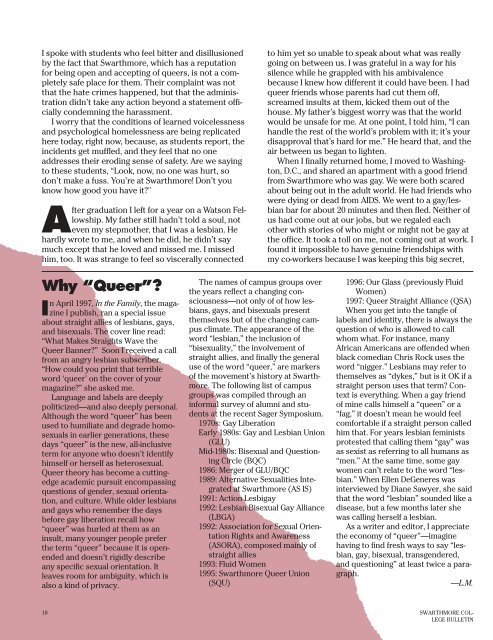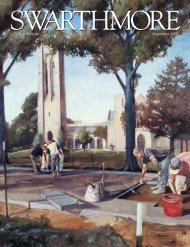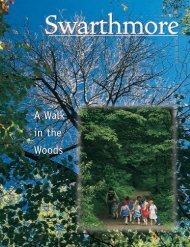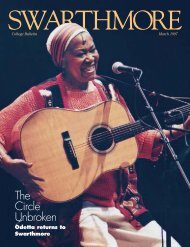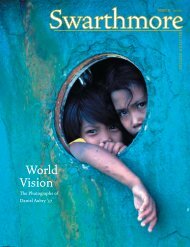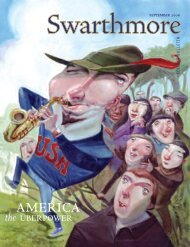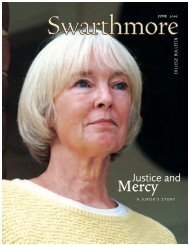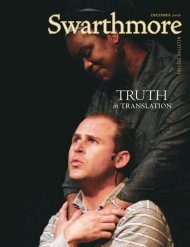Swarthmore College Bulletin (June 1998) - ITS
Swarthmore College Bulletin (June 1998) - ITS
Swarthmore College Bulletin (June 1998) - ITS
- No tags were found...
Create successful ePaper yourself
Turn your PDF publications into a flip-book with our unique Google optimized e-Paper software.
I spoke with students who feel bitter and disillusionedby the fact that <strong>Swarthmore</strong>, which has a reputationfor being open and accepting of queers, is not a completelysafe place for them. Their complaint was notthat the hate crimes happened, but that the administrationdidn’t take any action beyond a statement officiallycondemning the harassment.I worry that the conditions of learned voicelessnessand psychological homelessness are being replicatedhere today, right now, because, as students report, theincidents get muffled, and they feel that no oneaddresses their eroding sense of safety. Are we sayingto these students, “Look, now, no one was hurt, sodon’t make a fuss. You’re at <strong>Swarthmore</strong>! Don’t youknow how good you have it?"After graduation I left for a year on a Watson Fellowship.My father still hadn’t told a soul, noteven my stepmother, that I was a lesbian. Hehardly wrote to me, and when he did, he didn’t saymuch except that he loved and missed me. I missedhim, too. It was strange to feel so viscerally connectedto him yet so unable to speak about what was reallygoing on between us. I was grateful in a way for hissilence while he grappled with his ambivalencebecause I knew how different it could have been. I hadqueer friends whose parents had cut them off,screamed insults at them, kicked them out of thehouse. My father’s biggest worry was that the worldwould be unsafe for me. At one point, I told him, “I canhandle the rest of the world’s problem with it; it’s yourdisapproval that’s hard for me.” He heard that, and theair between us began to lighten.When I finally returned home, I moved to Washington,D.C., and shared an apartment with a good friendfrom <strong>Swarthmore</strong> who was gay. We were both scaredabout being out in the adult world. He had friends whowere dying or dead from AIDS. We went to a gay/lesbianbar for about 20 minutes and then fled. Neither ofus had come out at our jobs, but we regaled eachother with stories of who might or might not be gay atthe office. It took a toll on me, not coming out at work. Ifound it impossible to have genuine friendships withmy co-workers because I was keeping this big secret,Why “Queer”?In April 1997, In the Family, the magazineI publish, ran a special issueabout straight allies of lesbians, gays,and bisexuals. The cover line read:“What Makes Straights Wave theQueer Banner?” Soon I received a callfrom an angry lesbian subscriber.“How could you print that terribleword ‘queer’ on the cover of yourmagazine?” she asked me.Language and labels are deeplypoliticized—and also deeply personal.Although the word “queer” has beenused to humiliate and degrade homosexualsin earlier generations, thesedays “queer” is the new, all-inclusiveterm for anyone who doesn’t identifyhimself or herself as heterosexual.Queer theory has become a cuttingedgeacademic pursuit encompassingquestions of gender, sexual orientation,and culture. While older lesbiansand gays who remember the daysbefore gay liberation recall how“queer” was hurled at them as aninsult, many younger people preferthe term “queer” because it is openendedand doesn’t rigidly describeany specific sexual orientation. Itleaves room for ambiguity, which isalso a kind of privacy.The names of campus groups overthe years reflect a changing consciousness—notonly of of how lesbians,gays, and bisexuals presentthemselves but of the changing campusclimate. The appearance of theword “lesbian,” the inclusion of“bisexuality,” the involvement ofstraight allies, and finally the generaluse of the word “queer,” are markersof the movement’s history at <strong>Swarthmore</strong>.The following list of campusgroups was compiled through aninformal survey of alumni and studentsat the recent Sager Symposium.1970s: Gay LiberationEarly 1980s: Gay and Lesbian Union(GLU)Mid-1980s: Bisexual and QuestioningCircle (BQC)1986: Merger of GLU/BQC1989: Alternative Sexualities Integratedat <strong>Swarthmore</strong> (AS IS)1991: Action Lesbigay1992: Lesbian Bisexual Gay Alliance(LBGA)1992: Association for Sexual OrientationRights and Awareness(ASORA), composed mainly ofstraight allies1993: Fluid Women1995: <strong>Swarthmore</strong> Queer Union(SQU)1996: Our Glass (previously FluidWomen)1997: Queer Straight Alliance (QSA)When you get into the tangle oflabels and identity, there is always thequestion of who is allowed to callwhom what. For instance, manyAfrican Americans are offended whenblack comedian Chris Rock uses theword “nigger.” Lesbians may refer tothemselves as “dykes,” but is it OK if astraight person uses that term? Contextis everything. When a gay friendof mine calls himself a “queen” or a“fag,” it doesn’t mean he would feelcomfortable if a straight person calledhim that. For years lesbian feministsprotested that calling them “gay” wasas sexist as referring to all humans as“men.” At the same time, some gaywomen can’t relate to the word “lesbian.”When Ellen DeGeneres wasinterviewed by Diane Sawyer, she saidthat the word “lesbian” sounded like adisease, but a few months later shewas calling herself a lesbian.As a writer and editor, I appreciatethe economy of “queer”—imaginehaving to find fresh ways to say “lesbian,gay, bisexual, transgendered,and questioning” at least twice a paragraph.—L.M.18SWARTHMORE COL-LEGE BULLETIN


